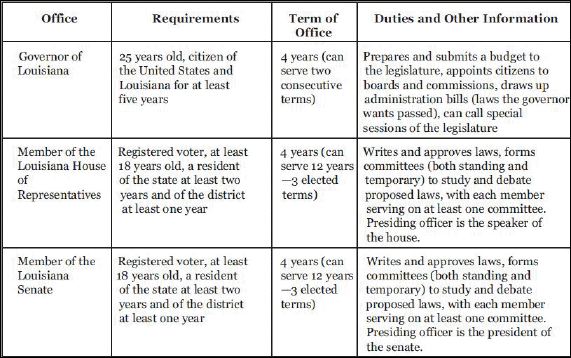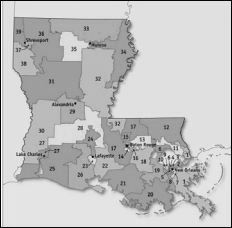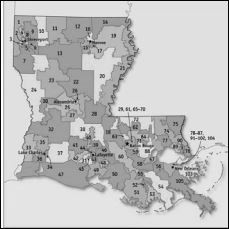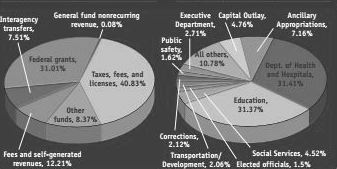Multiple Choice
Identify the
choice that best completes the statement or answers the question.
|
|
|
1.
|
Why did the U.S. Congress delay in approving
Louisiana’s statehood?
a. | The original document was not signed by the
delegates. | b. | U.S. Congress had
to vote to extend the deadline for statehood. | c. | Louisiana’s
constitution had to be translated from French into English. | d. | Louisiana’s constitution had to be translated from Spanish into English.
|
|
|
|
Population
Change

|
|
|
2.
|
According to the data in the population chart from
the 2010 U.S.Census, which three of the parishes listed have the greatest
population?
a. | Ascension, Bossier, and Caddo | b. | Caddo, Calcasieu, and Jefferson | c. | Bienville, Caldwell, and East Carroll | d. | Caddo, East Baton Rouge, and Jefferson |
|
|
|
3.
|
Why did democracy have to be learned in the new
state of Louisiana in 1812?
a. | No one wanted democracy.
| b. | The colony had no history of democratic
governance. | c. | The Spanish
population had no voice in the government. | d. | The English and
the French were arguing over the government. |
|
|
|
4.
|
What is federalism?
a. | doing one’s patriotic
duty | b. | an old form of government no longer in use
today | c. | a belief that all power should be in the hands of a few
people | d. | the division of power between the federal and state
governments |
|
|
|
5.
|
Which powers are shared by the state and federal
government?
a. | collect taxes and enforce
laws | b. | declare war and establish
schools | c. | conduct elections and establish
schools | d. | collect taxes and make treaties with other
nations |
|
|
|
6.
|
Why has Louisiana had so many different
constitutions?
a. | to try to agree on a version everyone
liked | b. | to create a government with certain goals in
mind | c. | to ensure that everyone had a part in the
process | d. | to make the constitution shorter and less
complex |
|
|
|
7.
|
Why was writing a new constitution an effective way
to control government?
a. | The constitution had to match the old
laws. | b. | New versions kept voters confused about the law.
| c. | Judges had a hard time understanding all the changes.
| d. | Constitutional principles are more powerful than
individual laws. |
|
|
|
8.
|
Which sets of words are correctly grouped
together?
a. | courts, interpret, judicial | b. | make laws, judge, judicial | c. | make laws, governor, judicial | d. | enforce laws, governor, legislative |
|
|
|
9.
|
ELECTED OFFICIALS OF STATE EXECUTIVE
BRANCH | | GOVERNOR | | SECRETARY OF STATE | | ATTORNEY GENERAL | | TREASURER | | COMMISSIONER OF
AGRICULTURE AND FORESTRY | | COMMISSIONER
OF INSURANCE | |
Which one of the elected officials of
the state executive branch is missing from the chart? a. | Chief Justice | b. | Lieutenant Governor | c. | Speaker of the
House | d. | State Superintendent of
Education |
|
|
|
10.
|
How is the state lieutenant governor’s job
similar to the U.S. vice-president’s?
a. | Each is appointed by the president and
governor. | b. | Both oversee the Department of Culture, Recreation, and
Tourism. | c. | If the president or the governor is unable to act the
vice-president or the lieutenant governor may step in for their respective
leaders. | d. | The vice president is ex officio president of the U.S.
Senate, and similarly the lieutenant governor is ex officio president of the state
senate. |
|
|
|
|
|
|
11.
|
Why must a bill go back to both houses after it
leaves the conference committee?
a. | The governor does not like to decide on the version he
likes best. | b. | Once a bill is
compromised it has to start the process all over again. | c. | The conference committee gets the final say in the passage of the
bill. | d. | Bill passage requires approval of identical versions of
the bill by both chambers. |
|
|
|
12.
|
According to the chart, where are all the places
that a bill can be stopped from becoming a law?
a. | governor | b. | committee and governor | c. | committee, floor,
and governor | d. | conference
committee, committee, floor, and governor |
|
|
|
Study the chart below and use it to answer the
following question(s).

|
|
|
13.
|
If Lavon is elected to the Louisiana Senate when
he’s 18, what is the fewest number of terms he could serve before he meets all the
requirements to run for governor?
a. | 1 term | b. | 2 terms | c. | 3
terms | d. | 4 terms |
|
|
|
14.
|
A twenty year old friend moved from Baton Rouge, where she had always lived, to
Monroe, Louisiana, last month. She is very interested in serving in public office but was told she
did not meet the requirements to run for the Louisiana House of Representatives. Which fact would
keep your friend from being a Representative?
a. | The governor must appoint each Representative. | b. | A Representative
must live in the district for a least one year. | c. | Women cannot serve in the Louisiana House of
Representatives. | d. | A Representative must have lived in the state
for at least two years. |
|
|
|
15.
|
If a government is bicameral, what does that
mean?
a. | Term limits are always two
years. | b. | The legislative branch has two houses or chambers.
| c. | There are two levels of government, state and national.
| d. | The executive branch has a leader and a secondary leader
who can take the leader’s place. |
|
|
|
16.
|
How is a clerk of the court for a parish like the
secretary of state for the state?
a. | Both keep official records. | b. | Each is responsible for the state seal. | c. | Both function at the local level of government. | d. | Both are members of the judicial branch of government.
|
|
|
|
17.
|
How are a grand jury and a trial jury
different?
a. | A grand jury is part of the executive branch, and a
trial jury is part of the judicial branch. | b. | A grand jury
decides if there is enough evidence to go to trial, but a trial jury renders a verdict based on
evidence. | c. | A police jury
decides if there is enough evidence to go to trial, but a trial jury renders a verdict based on
evidence. | d. | A trial jury decides if there is enough evidence to go
to trial, but a grand jury renders a verdict based on
evidence. |
|
|
|
18.
|
HISTORICAL OIL SEVERANCE TAX RATES
The first tax, based on the severance of oil was imposed
in 1910. This tax was
levied as an occupational license tax at a rate of 2/5¢ per barrel of
oil. There
have been many changes in the tax rates since 1910, including fluctuations from
a
volumetric to a percentage-of-value based tax. The changes are listed below in
chronological
order
1910 Oil and condensate 2/5¢ per barrel
1912 Oil and condensate 0.5% of
gross value less royalty interest
1920 Oil and condensate 2% of gross value
1922 Oil and
condensate 3% of gross market value
1928 Oil and condensate 4 -11¢ per barrel depending on
gravity
1940 Oil 6-11¢ per barrel depending on gravity; condensate 11¢ per barrel
1948 Oil 18-26¢ per barrel depending on gravity; condensate 20¢ per barrel
1974 Oil
and condensate 12.5% of value
http://dnr.louisiana.gov/assets/TAD/data/severance/la_severance_tax_rates.pdf | |
What conclusion can be drawn from the chart about the severance tax
change between 1910 and 1974? a. | The increase in severance tax decreased oil removal.
| b. | The tax rate decreased because the value of oil
increased. | c. | As more oil was
removed, less was available for future generations, and so the tax rate
increased. | d. | As the tax
increased more people lost their jobs in the oil industry, so more severance pay was required.
|
|
|
|
19.
|
What is the largest single source of revenue for
the state?
a. | excise tax | b. | property tax | c. | sales
tax | d. | severance tax |
|
|
|
20.
|
 
SENATE LEGISLATIVE DISTRICTS HOUSE LEGISLATIVE
DISTRICTS
From the maps, what can you infer about legislative representation?
a. | Each district covers the same amount of territory.
| b. | There are more members of the House than the
Senate. | c. | Some voters have to vote in two different places because
of their districts. | d. | The districts do
not represent the people fairly because the districts are different
sizes. |
|
|
|
Louisiana Revenue and Expenses

|
|
|
21.
|
Based on the graphs, what conclusion can be drawn
about Louisiana’s budget in 2004-2005?
a. | It is a balanced budget. | b. | High priority is given to public safety. | c. | Some money is held back in reserve every year. | d. | All of the money from federal grants is spent on
education. |
|
|
|
22.
|
What are the two types of local
government?
a. | elected parish council and police
jury | b. | county government and parish
council | c. | appointed parish council and police jury
| d. | consolidated government and county
government |
|
|
|
23.
|
Why are school boards more closely regulated than
other forms of local government?
a. | They finance schools using federal
funds. | b. | They receive money from the
state. | c. | School boards have the power to sell bonds.
| d. | They are not part of parish government, even though they
share boundaries. |
|
|
|
24.
|
| Beau, a registered Democrat, has ten candidates on the
ballot, both Democrat and Republican. He can vote for whomever he chooses.
| |
In which type of election is Beau voting?a. | closed primary | b. | final election | c. | open
primary | d. | run-off election |
|
|
|
25.
|
What is the role of the professional lobbyist?
a. | They are criminals who buy influence with government
officials. | b. | They are paid
professionals who only work to influence government in Washington D.C. | c. | They are regular citizens who work as volunteers to sway legislators to vote
in the way they think best. | d. | They are paid to
represent a particular point of view with legislators and other government officials.
|
|
|
|
26.
|
Which example of citizen involvement in government
is illegal?
a. | working in a polling place | b. | volunteering in campaigns | c. | lobbying for their favorite cause | d. | paying legislators for their votes |
|
|
|
27.
|
What is a constituent?
a. | a type of local government | b. | an amendment to the constitution | c. | someone represented by an elected official | d. | someone who represents a defendant in a court of
law |
|
|
|
28.
|
What is reapportionment?
a. | a governor’s override of a
bill | b. | dividing the state budget so it will
balance | c. | the process of redrawing legislative district
boundaries | d. | making people
relocate to new parishes to keep the voting numbers even |
|
|
|
29.
|
How does the judicial branch check and balance the
legislative branch?
a. | The judges can vote to override the governor’s
veto. | b. | A law can be put on the ballot by the judicial
branch. | c. | The judicial branch can declare a law unconstitutional.
| d. | Once a law is declared unconstitutional, the judicial
branch can create a replacement. |
|
|
|
30.
|
What is the purpose of criminal laws?
a. | organize the judicial system | b. | determine how an election should be run | c. | protect society from an individual’s
wrongdoing | d. | enable
citizens to sue each other in a court of law |
|